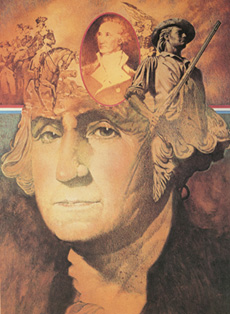
Colonel George Washington
In 1753 the governor of Virginia appointed George Washington, a self-reliant young surveyor, as Adjutant with the rank of major over one of the state's four military districts. As a lieutenant colonel in the French and Indian Wars, Washington soon saw first hand the problems faced by citizen-soldiers who left their homes and plows to resist the French. Victorious in their first skirmish, Washington and his Virginians erected Fort Necessity and later had to withdraw. In the retreat Washington won the affection of his men and kept up their spirits with his personal example. In 1775 Washington and his militia joined British General Edward Braddock to clear the French out of the Ohio Valley. Braddock died in battle praising Washington and his blue-clad Virginians for their courage in saving part of the English forces. From 1758 to 1775 Washington served his home state in a variety of ways. He commanded the Virginia Militia as Colonel Washington. He served in the Virginia House of Burgesses and the Continental Congress. When the Continental Congress sought a commander for the Colonial Army, they turned to George Washington of Virginia as the logical choice. Washington's militia experience during the French and Indian Wars stood him in good stead during the American Revolution. He had learned how to get the most out of limited manpower and military stores. More than that, he knew that the esprit de corps of militia, even ill-trained and poorly equipped, could be the fighting equal of British professionals. Washington became the first president of the United States of America in 1789.
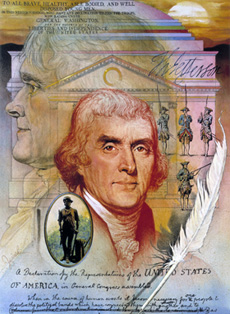 Thomas Jefferson
Thomas Jefferson
In 1770, at the age of 27, the Governor of Virginia appointed Thomas Jefferson as the county lieutenant, with the rank of colonel, of the Albemarle County Militia. Colonel Jefferson was responsible for all militia affairs in the county including insuring that the Albermarle County Regiment of Militia drilled on a regular basis, that the regimental and company muster rolls were kept up, and that militia fines were collected by the sheriff. Jefferson also presided over courts-martial and councils of war. With the start of the Revolutionary War, Colonel Jefferson's military duties increased. He reported directly to the governor in preparing the county militia for mobilization. Jefferson was also responsible for providing militia soldiers as replacements for the Virginia regiments of the Continental Army. He found the time to represent Virginia at the Continental Congress which adopted the Declaration of Independence on July 4, 1776, written almost entirely by Jefferson. Elected governor in 1779, Jefferson resigned his militia commission. As commander-in-chief of the Virginia militia, he mobilized the militia to reinforce the Continental Army in the Southern campaign which ended in victory at Yorktown on October 19, 1781. Jefferson later served as Minister to France, Secretary of State and Vice President. Architect, scholar, statesman and citizen-soldier, Thomas Jefferson became the third president of the United States in 1801.
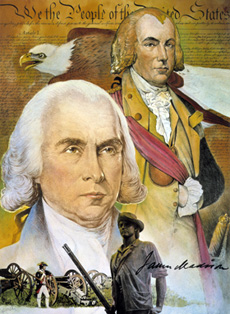 Colonel James Madison
Colonel James Madison
In 1775, after serving briefly as a private, James Madison was commissioned as colonel and commander of the Orange County Regiment, Virginia Militia. Colonel Madison was responsible for the training and readiness of his regiment. Although frail health precluded active service, Madison gained prominence as a patriot and statesman. In 1776 he was elected to the Virginia Constitution Convention where he helped to frame a constitution and bill of rights. Madison was elected to the Continental Congress in 1780. In 1781, Colonel Madison was appointed county lieutenant of Orange County, Virginia, and was responsible for all militia affairs in the county including supervising the training of the militia. While serving in the Virginia legislature, he led the effort to convene a national constitutional convention which met in the summer of 1787. If not the father of the Constitution, Madison was certainly its prime architect. His Virginia Plan called for a national government with three branches which would be supreme over the states. Madison also played a critical role in convincing the states to ratify the Constitution. After serving as a congressman and Secretary of State, James Madison was inaugurated as the fourth president of the United States in March 1809.
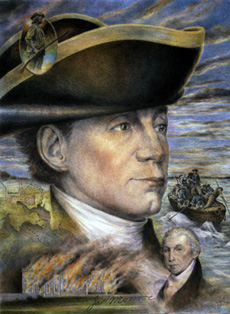 Lieutenant Colonel James Monroe
Lieutenant Colonel James Monroe
James Monroe was a student at the College of William and Mary when he joined the Continental Army's 3d Virginia Regiment in September, 1775. Lieutenant Monroe distinguished himself in several battles, and was wounded at Washington's Christmas Eve victory in Trenton. Monroe resigned from the Army in 1778, and the next year George Washington recommended him for command of a regiment of Virginia state troops. He was appointed a Lieutenant Colonel, but there was no money to pay more Virginia troops, and so in 1780 Monroe who burned parts of the American capitol in August, 1814 before being turn began to study law under Virginia Governor Thomas Jefferson. In October 1780 the British invaded Virginia, and Monroe found himself the colonel of an "emergency regiment" of militia which he himself had rushed to raise and organize. As the war ended, Monroe entered politics, and in 1790 was elected one of Virginia's first U.S. senators. He was governor twice, and Secretary of State and Secretary of War under President James Madison. As Secretary of War, he oversaw operations against the British, back at Baltimore. In 1816, Monroe became President, and during his two terms strengthened the nation's coastal defenses; acquired Florida from Spain; saw the passage of the Missouri Compromise, which attempted to restrict the growth of slavery; and finally, issued what became known as the "Monroe Doctrine," which warned the European powers against military or political interference with their former colonies in North and South America. The fourth President with militia service, Monroe was the last of the Revolutionary War generation to serve as Chief Executive.
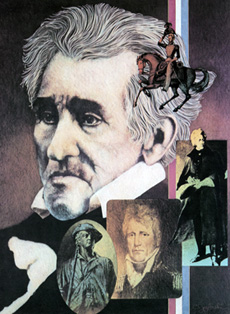 Major General Andrew Jackson
Major General Andrew Jackson
Andrew Jackson began his military career at the age of 13 when he joined the men and boys of his community to fight off the British at Hanging Rock during the last year of the American Revolution. He entered a law career in North Carolina, then he turned it into a political career in Tennessee. He was known as an able, industrious and skillful man who was relentless, straight-forward and plain spoken. Jackson was a local celebrity in Tennessee and a major general in the Tennessee Militia. He and his Tennessee riflemen fought two bitter campaigns against the Creek Indians in the winter and spring of 1813. His exploits became nationally known. In 1814 Jackson was commissioned a major general in the Regular Army of the United States to fight the British at Pensacola. Within a month he stormed Pensacola, and a month later he fought the long-remembered Battle of New Orleans. It was during this battle that Jackson improvised on the arts of war with an unusual combination of Creole Louisiana militia, sharpshooting Tennessee riflemen, free Negroes, Lafitte's pirates, and city volunteer militia units. In 45 minutes the British were defeated. Andrew Jackson became the seventh president of the United States of America in 1829.
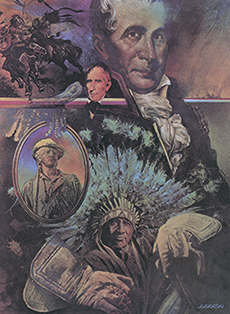 Major General William H. Harrison
Major General William H. Harrison
Spurred by accounts of Indian Atrocities on the western frontier, Harrison left his medical studies in Virginia to join the Army as a sub lieutenant in 1791. After serving in the Northwest Territory, he resigned from the Army in 1798. In 1800, Harrison was made the governor and superintendent of Indian Affair for the territory of Indiana. After a series of attacks by Tecumseh, Harrison lead a force of one thousand men, composed mostly of militia and volunteers, to the Indian settlement at Tippecanoe. After a fierce fight, the Indians were forced to retreat by a cavalry charge. Harrison was highly complimented by President Madison and the Kentucky and Indiana legislature for his part in the victory. After the battle, he was given the nickname "Tippecanoe." During the War of 1812 Harrison served as a major-general with the Kentucky militia before he was appointed to the supreme command of the Army of the North-West. He recaptured Detroit in the fall of 1813 and then decisively defeated the British and their Indian allies on the Thames near Thomasville, Ontario. Harrison's forces included 4,000 volunteers commanded by the governor of Kentucky. Harrison later received a gold medal from Congress for his victory on the Thames. He became the 9th president of the United States in 1840.
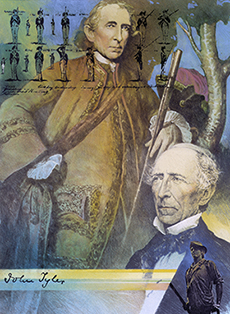 Captain John Tyler
Captain John Tyler
Like his father, John Tyler strongly supported America's role in the war of 1812. As a young legislator in the Virginia House of Delegates, Tyler voted for every anti-British measure proposed during the 1812 session. In the summer of 1813, word reached Tyler that a British raiding party had plundered Hampton, Virginia, and appeared ready to march up the James River to Richmond. He immediately joined the Charles City Rifles, a local militia company formed to defend Richmond. A large part of the force consisted of farmers who were new to military discipline. Tyler, commissioned as a captain, organized the men through a simple drill system. The company was attached to the Fifty-second Regiment of the Virginia Militia and ordered to Williamsburg to resist the advancing British. Tyler's company was later attached to the Second Elite Corps of Virginia under the command of General Moses Green. When the British withdrew from Hampton, Tyler and his men returned home triumphant. John Tyler became the 10th president of the United States in 1841.
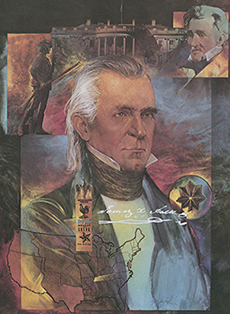 Major James Knox Polk
Major James Knox Polk
Two states shared the youth and education of James Knox Polk, 11th president of the United States of America. He was born in North Carolina in 1795 in the afterglow of the American Revolution and as a lad moved with his family to larger lands in Tennessee. He was weak and sickly in his early years but gained strength in his teens. Following undergraduate study at the University of North Carolina, he read law under Tennessee's most prestigious attorney, Judge Felix Grundy of Nashville. It was in Nashville that Polk met Andrew Jackson and began a lasting and rewarding friendship. They came to be called "Old Hickory and Young Hickory." In 1821 Polk was chosen a captain (and later a major) in the Maury County militia. But Polk's service to his state and country was to be more political than military. He rose rapidly to Congress, becoming speaker of the House during the difficult years of 1835-39. In 1840 he became governor of Tennessee, but failed to win reelection. However, as the first "dark horse" in American presidential history, he won the Democratic nomination in 1844 and defeated Henry Clay in the November election. During the single term of the presidency of James Knox Polk, the United States acquired the territories which now comprise Texas, New Mexico, California and Oregon.
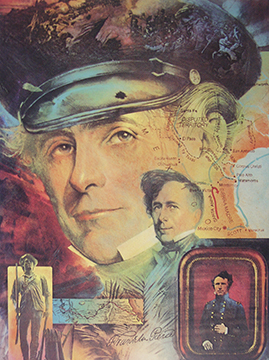 Brigadier General Franklin Pierce
Brigadier General Franklin Pierce
Franklin Pierce was born in 1804 with the militia tradition in his veins, the son of a hero of the American Revolution who was among Washington's most trusted combat officers. Young Franklin attended Bowdoin College in Maine and while there formed a life-long friendship with Nathaniel Hawthorne, later one of his biographers. Upon graduation, he returned to his native state of New Hampshire and read for the law. Politics caught his fancy and his ambitions. He was a stirring orator as well as a tireless worker, and his progress was rapid: member of the state legislature by 1828; its speaker by 1831. That same year he was appointed a colonel in the New Hampshire militia and served as the governor's aide-de-camp. He retired from Congress in 1842 and returned to state politics and his law practice in Concord, New Hampshire. The 1846-48 Mexican War took him into active military service as a brigade commander in General Winfield Scott's army. Pierce brought his troops in good order from New England to Veracruz and then overland to join Scott in the field before Mexico City. He participated bravely in numerous engagements, acquiring a bullet hole in the brim of his hat, and showed himself to be his father's son. In 1853 Franklin Pierce became the 14th president of the United States of America.
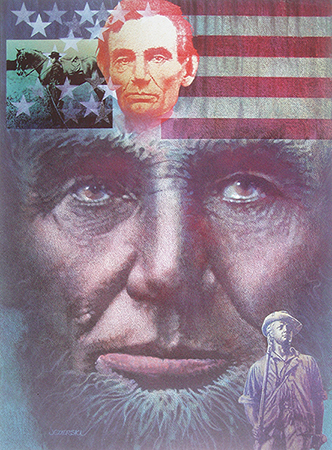 Captain Abraham Lincoln
Captain Abraham Lincoln
In 1832 the governor of Illinois called for the state militia to campaign against the Indians under Black Hawk. Black Hawk was the war chief of the Sacs, who had tried to reclaim territories which they had given up by treaties. Young Abraham Lincoln joined a volunteer company and was elected captain. He said later that he had no success in life which gave him so much satisfaction as his experience with the Illinois Militia. When it appeared that his unit would not see service, many of its members disbanded and went home. This group included Abraham Lincoln . . . who left because he wanted to be of real service. On the same day Lincoln was mustered out, however, he reenlisted as a private . . . in a scouting service sometimes called the Independent Spy Battalion. He was mustered out of the Battalion on June 16, 1832. In 1861 Abraham Lincoln became 16th president of the United States of America.
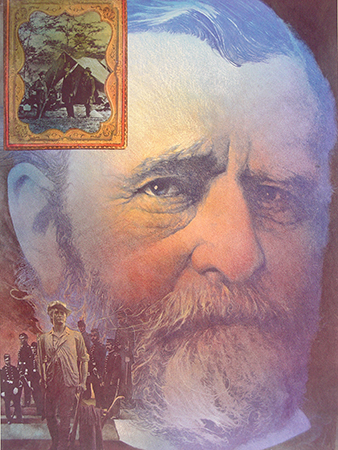 Lieutenant General Ulysses Grant
Lieutenant General Ulysses Grant
The outbreak of the Civil War found Ulysses S. Grant working as a clerk in his brother's leather store in Illinois. Although he had been graduated from West Point and had served with distinction in the Mexican War, Grant had no intention of making his career in the military. He resigned from the Army as a captain in 1854 and held a series of odd jobs, including selling firewood in the streets of St. Louis. Upon Lincoln's call for volunteers, Grant applied in vain to the federal government for a commission. However, he was appointed a colonel of the 21st Illinois volunteers in June of 1861. When Grant's forces attacked Fort Donelson and the Confederate commander tried to negotiate, Grant replied that "no terms except an unconditional and immediate surrender can be accepted." The subsequent capitulation earned him the nickname "Unconditional Surrender Grant" (a play on his initials) and prompted Lincoln to name him a major-general of volunteers. Victories at Vicksburg and Chattanooga confirmed his reputation as a winner, and on March 17, 1864. Lincoln gave him formal control of all northern armies. Union troops suffered severe losses as Grant forced the Confederate army to retreat towards Richmond. Answering criticism of his tactics, Grant declared after the bloody fighting at Spotsylvania Court House: "I propose to fight it out on this line if it takes all summer." On April 9, 1865, after the capture of Petersburg and Richmond, Robert E. Lee surrendered to Grant at the Appomattox Court House. In 1869, Ulysses S. Grant became the 18th president of the United States.
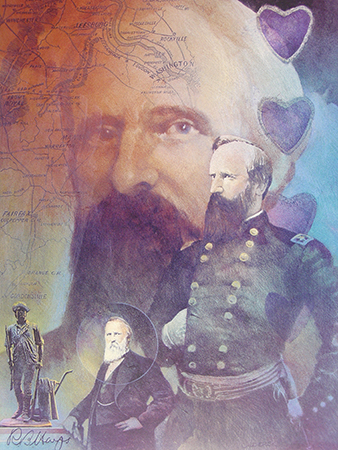 Major General Rutherford B. Hayes
Major General Rutherford B. Hayes
With the start of the Civil War, Rutherford Hayes left a life of leisure to accept a commission as a major in the 23rd Ohio Infantry. Hayes enjoyed the rugged military life and fought bravely, receiving four wounds in action during his service. In the fall of 1862, he led a charge in the Battle of South Mountain, Maryland. Despite receiving heavy losses in his unit and a musket wound himself, Hayes held his position. He was promoted to colonel and in 1863 his troops helped stop Morgan's raiders at Buffington, Ohio. During the Battle of Winchester, Virginia, 1864, his unit's flags were the first to enter the town. Later that year, Hayes was wounded for the fourth time in the Battle of Cedar Creek. After the battle, he was promoted to brevet brigadier general on the recommendation of General George C. Crook. In 1865, Hayes was elected to the House of Representatives without campaigning. He believed that "any officer fit for duty, who at this crisis would abandon his post to electioneer for a seat in Congress, ought to be scalped." He was brevetted a major general of volunteers "for gallant and distinguished services during the campaign of 1864 in West Virginia..." Rutherford Hayes became the 19th president of the United States in 1877. He looked back on his wartime service as "the best years of our lives."
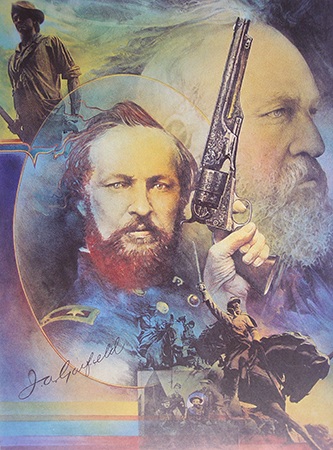 James A. Garfield
James A. Garfield
On the eve of the Civil War in 1859, attorney and educator James A. Garfield was elected to the Ohio State Senate on the anti-slavery vote. He had previously served as principal of Hiram College and was a member of the Ohio bar. In August of 1861, he was commissioned a lieutenant colonel in the 42nd Ohio Infantry, 17th Brigade, then reported in December to Kentucky and was placed in command of the 17th Brigade. At the Big Sandy River, his troops were outnumbered five to one but held until reinforcements arrived. Garfield then attacked the Confederates at Middle Creek, Kentucky, and won after a five-hour battle. He was promoted to brigadier general and assigned to the 20th Brigade at Columbia, Tennessee, where he joined General Ulysses S. Grant. He reached Shiloh on the second day of the battle and helped drive back the Confederates. In February of 1863, he joined the army of Cumberland under General William S. Rosecrans and was appointed chief to staff. For his actions at the battle of Chickamauga, Garfield was promoted to major general of Ohio Volunteers. Garfield was elected to Congress in 1862 on the condition that he take the seat in December of '63, when it was thought the war would be over. He was ready to accept command of a division as the war dragged on, but Lincoln and Secretary of War Stanton urged him to take the seat because of his value as a legislator. He resigned his commission on December 5th and took his seat in Congress two days later. James Garfield became the 20th president of the United States in 1881.
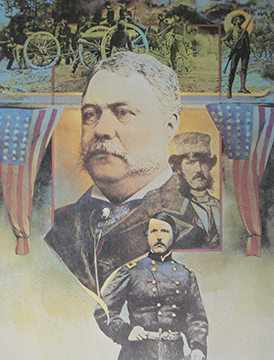 Brigadier General Chester Arthur
Brigadier General Chester Arthur
As a judge advocate in the New York State Militia, Chester Arthur played an active role in that unit's reorganization. With the start of the Civil War, the governor appointed him as New York's acting quartermaster-general (today's logistical officer) of the State Militia. In January of 1862, Arthur submitted a report detailing the condition of the national forts defending New York harbor. He was promoted to brigadier general and inspected the New York troops at Fredericksburg and on the Chickahominy River. Arthur was called from the Army of the Potomac to serve as secretary for the meeting of the governors of the loyal states. On July 10th of that same year, he was officially appointed to the post of quartermaster-general. Arthur's annual report stated that in one four-month period, his office in New York had "completely clothed, uniformed, and equipped, supplied with camp and garrison equipage, and transported from this state to the seat of war, sixty-eight regiments of infantry, two battalions of cavalry, and four battalions of artillery." Chester Arthur became the 21st president of the United States in 1881.
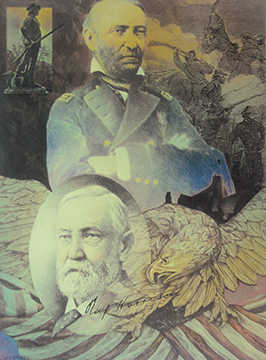 Brigadier General Benjamin Harrison
Brigadier General Benjamin Harrison
When the Civil War began, Benjamin Harrison had already distinguished himself as prominent Indiana attorney. He took an active interest in politics and joined the Republicans in their opposition to slavery. In 1862, Harrison helped from the 70th Indiana Infantry and was given command of a regiment as a colonel. He believed in strict, systematic drilling and soon brought his men to excellent fighting form. He saw his first action at Russellville, Kentucky and spent the next fifteen months in Kentucky and Tennessee with his regiment. In 1864, his command was attached to Sherman's army and fought in the Atlanta campaign. The unit saw its fiercest action in Resaca, Georgia, where Harrison was among the first to storm the Confederate position. After the Battle of Nashville, Harrison was brevetted brigadier general "for ability and manifest energy and gallantry." On April 26, 1865, he witnessed the surrender of General Joseph Johnson to General Sherman at Durham's Station, North Carolina. Harrison received his commission as brigadier general on May 9 and was honorably discharged a month later. Benjamin Harrison became the 23rd president of the United States in 1889.
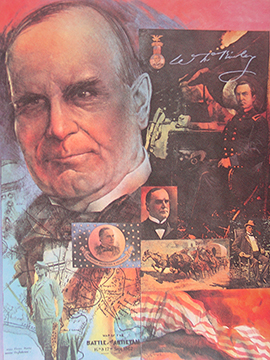 Major William McKinley, Jr.
Major William McKinley, Jr.
William McKinley's public career opened and closed against the background of great national conflicts-the Civil War, which he joined as a private at the age of 18, and the Spanish-American War, which he ably prosecuted as commander-in-chief. During the Civil War he rose to the rank of captain, most of the time in the 23rd Ohio Volunteers, where he served with distinction under Rutherford B. Hayes, later 19th president. Hayes described McKinley as "a handsome, bright, gallant boy," and "one of the bravest and finest officers in the Army." On one occasion, as a commissary sergeant at the battle of Antietam, he personally drove a wagon of hot rations through the thick of the fighting to his troops-a novel exploit that was widely praised. On another, as a captain and aide-de-camp at Kernstown in the Shenandoah Valley, he galloped under fire to give an independent regiment the word to fall back. He left military service and returned to Ohio with a brevet (or honorary) commission of major signed by Abraham Lincoln. In the years that followed, he applied himself diligently to the law, and to politics with patient and irresistible success. He represented Ohio for many terms in the U.S. House of Representatives, and was twice governor. In 1897 William McKinley became the 25th president of the United States of America.
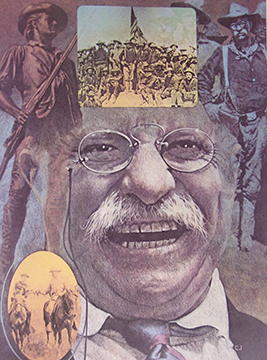 Theodore Roosevelt
Theodore Roosevelt
Theodore Roosevelt was appointed a second lieutenant in Company B, Eight Regiment, New York National Guard in 1882. He resigned from the National Guard a captain in 1886. Years later he described his experience in the National Guard as "invaluable." With a clear memory of some of his experiences in the National Guard and as a colonel with the United States Army in Cuba during the Spanish-American War, Roosevelt became 26th president of the United States in 1901. His first message to the United States Congress called for a "thorough military education" not only for the Regulars but for officers of the Guard "and others in civil life who desire intelligently to fit themselves for possible military duty." Roosevelt stated, "I believe no other great country has such fine natural materials for volunteer soldiers as we have, and it is the obvious duty of the nation and the states to make such provision as will enable the volunteer soldiery to be organized with all possibly rapidity and efficiency in time of war, and furthermore to help in every way the National Guard in time of peace. Roosevelt was instrumental in enacting much of the legislation which modernized the National Guard. By the time he left office, the National Guard had been incorporated with the Army as part of the nation's military forces . . . with uniform equipment, clothing, and training.
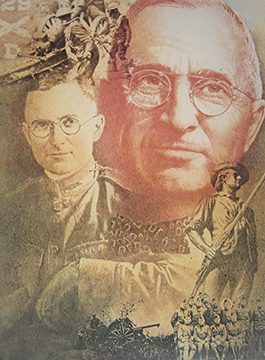 Captain Harry S. Truman
Captain Harry S. Truman
Harry Truman became a charter member of the newly formed Battery B of the Missouri National Guard on June 14, 1905 where he served as battery clerk and was discharged a corporal in 1906. But with the United States declaration of war on Germany, he reenlisted in the Missouri National Guard, where he was elected first lieutenant at the age of 33 in the 2nd Missouri Field Artillery. On August 5, 1917 his unit was sworn into the Regular Army as the 129th Field Artillery on the 35th Division. He was given command of Battery D on July 11, 1918 in Brittany. Captain Truman developed his battery into a topnotch combat unit. At the end of a month the battery was setting regimental records for firing accuracy and speed in disassembling, moving and setting up the guns for firing. Truman had won the unit's respect and admiration as well. Truman's concern and respect for his unit can be summed up with his own comment, "I want to tell you this, too, fellows. Right now, I'm where I want to be-in command of this battery. I'd rather be here than president of the United States." Harry S. Truman was discharged from the U.S. Army as a captain in 1919. He became 33rd president of the United States of America in 1945. His World War I service stood him in good stead as he realized the critical importance of capable and competent leadership and the value of team work. Today the 129th Field Artillery maintains a Battery D "Truman's Battery"-the only Battery D in the National Guard-in his honor.
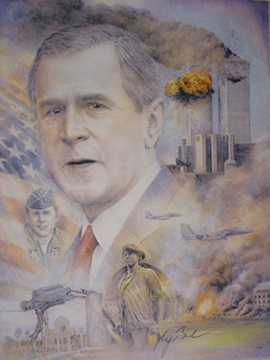 First Lieutenant George W. Bush
First Lieutenant George W. Bush
After graduating from Yale University in 1968, George W. Bush joined the Texas Air National Guard's 147th Fighter Group at Ellington Field, completed Air Force flight training, and served as an F-102 fighter pilot before he left the Guard in 1973. He received a master's of business administration degree from the Harvard Business School in 1975. Following a career in the oil business and part ownership of the Texas Rangers major league baseball team, Bush was elected Governor of Texas in 1994 and reelected four years later. Inaugurated as the 43rd President of the United States in January 2001, he was the first former Air Guardsman to serve as Commander-In-Chief of the nation's armed forces and only the second son of a former chief executive to assume the responsibilities of the Oval Office. During this first term, although he promoted a sweeping revamping of public education, taxes, national defense, Social Security, and Medicare, he was best known for his steadfast leadership of the nation following the terrorist attacks on New York City and the Pentagon with hijacked airliners on September 11, 2001. After those attacks, which killed some 3,000, Bush reassured the American people with his courage and determination while strengthening the nation's homeland defenses and launching a "Global War on Terrorism." The latter included rapid military victories that toppled the radical Islamic regime in Afghanistan in 2002 which had sheltered the Al Qaeda terrorist organization responsible for the September 11th attacks on the U.S., and overthrew Saddam Hussein's brutal Iraqi dictatorship in 2003. Bush was inaugurated for a second term in January 2005. He was the twentieth member of the militia and National Guard to serve as the nation's chief executive.